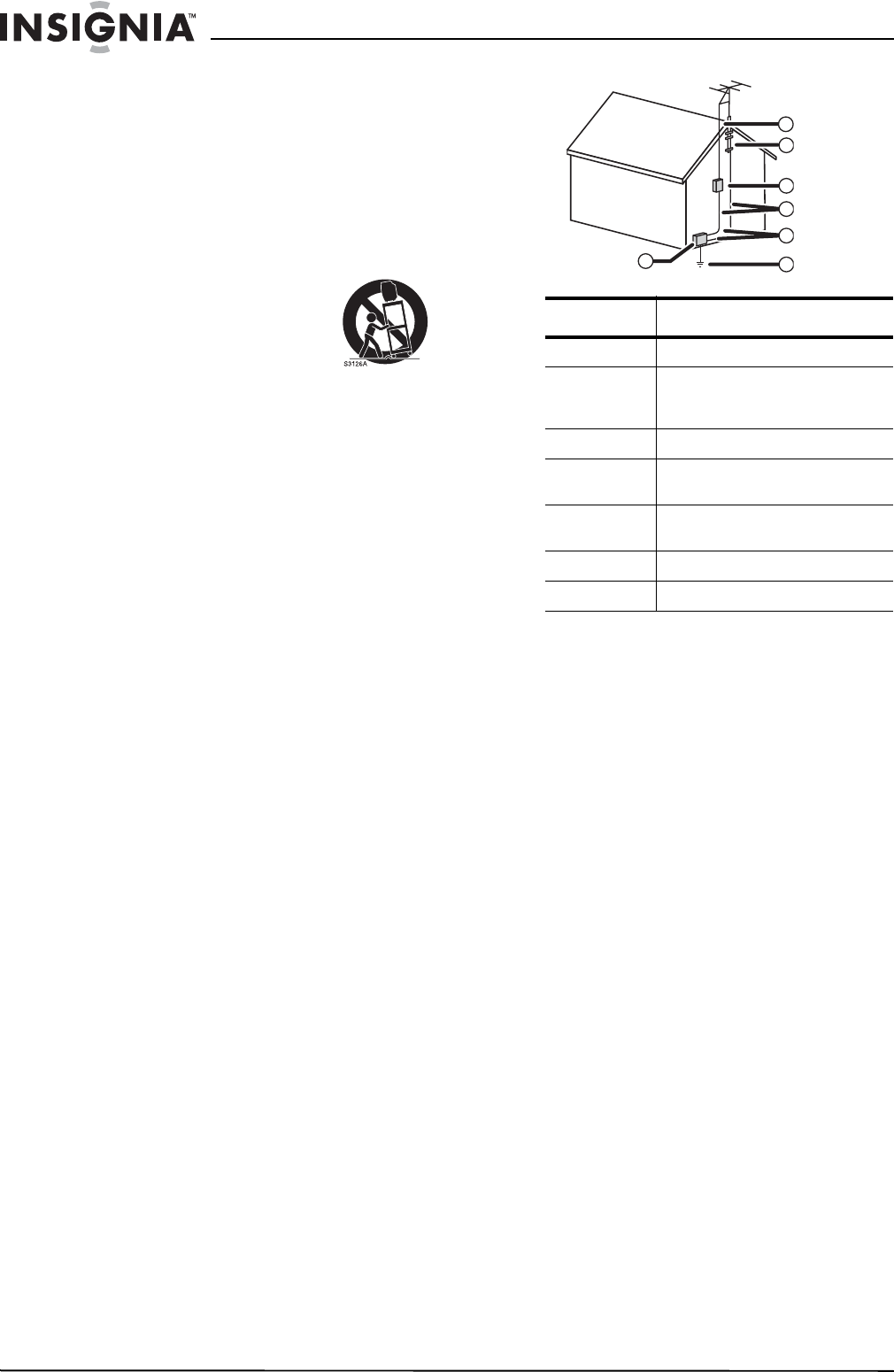
2
NS-DVDR1 DVD Recorder
www.insignia-products.com
• Water and moisture–Do not use your
recorder near water, for example, near a bath
tub, wash bowl, kitchen sink, or laundry tub,
in a wet basement, or near a swimming pool.
• Accessories–Do not place your recorder on
an unstable cart, stand, tripod, bracket, or
table. Your recorder may fall, causing serious
injury to someone and serious damage to
your recorder. Use only with a cart, stand,
tripod, bracket, or table recommended by the
manufacturer, or sold with your recorder.
If you mount your recorder,
follow the manufacturer's
instructions and use a mounting
accessory recommended by the
manufacturer. Move a recorder
and cart combination with care.
Quick stops, excessive force,
and uneven surfaces may cause your
recorder and cart combination to overturn.
• Ventilation–Slots and openings in the
cabinet and the back or bottom are provided
for ventilation, to ensure reliable operation of
your recorder and to protect it from
overheating. Do not block openings. Do not
place your recorder on a bed, sofa, rug, or
other similar surface. Your recorder should
never be placed near or over a radiator or
heat register. Do not place your recorder in a
built-in installation such as a bookcase or
rack unless correct ventilation is provided or
the manufacturer’s instructions have been
adhered to.
• Power sources–Use only the type of power
source indicated on the marking label. If you
are not sure of the type of power supply to
your home, consult your recorder dealer or
local power company. For recorders intended
to operate from battery power, or other
sources, refer to the operating instructions.
• Grounding or polarization–Your recorder is
equipped with a polarized alternating-current
line plug (a plug having one blade wider than
the other). This plug will fit into the power
outlet only one way. This is a safety feature. If
you are unable to insert the plug fully into the
outlet, try reversing the plug. If the plug
should still fail to fit, contact your electrician
to replace your obsolete outlet. Do not defeat
the safety purpose of the polarized plug.
• Power-cord protection–Route power-supply
cords so that they are not likely to be walked
on or pinched by items placed upon or
against them, paying particular attention to
cords at plugs, convenience receptacles, and
the point where they exit from your recorder.
• Outdoor antenna grounding–If an outside
antenna or cable system is connected to your
recorder, make sure that the antenna or
cable system is grounded so as to provide
some protection against voltage surges and
built-up static charges. Article 810 of the
National Electrical Code, ANSI/NFPA No. 70,
provides information with respect to correct
grounding of the mast and supporting
structure, grounding of the lead-in wire to an
antenna discharge unit, size of grounding
conductors, location of antenna-discharge
unit, connection to grounding electrodes, and
requirements for the grounding electrode.
• Lightning–For added protection for your
recorder during a lightning storm, or when it
is left unattended and unused for long
periods of time, unplug it from the wall outlet
and disconnect the antenna or cable system.
This will prevent damage to your recorder
due to lightning and power-line surges.
• Power lines–An outside antenna system
should not be located in the vicinity of
overhead power lines or other electric light or
power circuits, or where it can fall into such
power lines or circuits. When installing an
outside antenna system, do not touch power
lines or circuits because contact with them
might be fatal.
• Overloading–Do not overload wall outlets
and extension cords because this can result
in a risk of fire or electric shock.
• Object and liquid entry–Never push objects
of any kind into your recorder through
openings because they may touch dangerous
voltage points or short out parts that could
result in a fire or electric shock. Never spill
liquid of any kind on your recorder.
• Servicing–Do not attempt to service your
recorder yourself because opening or
removing covers may expose you to
dangerous voltage or other hazards. Refer all
servicing to qualified service personnel.
•
Damage requiring service–Unplug your
recorder from the wall outlet and refer
servicing to qualified service personnel under
the following conditions:
• When the power supply cord or plug is
damaged or frayed.
• If liquid has been spilled, or objects have
fallen into your recorder.
• If your recorder has been exposed to rain
or water.
Reference Grounding component
1 Electric service equipment
2 Power service grounding
electrode system
(NEC Art 250, Part H)
3 Ground clamp
4 Grounding conductors (NEC
Section 810-21)
5 Antenna discharge unit (NEC
Section 810-20)
6 Ground clamp
7 Antenna lead-in wire
6
7
5
2
1
3
4


















